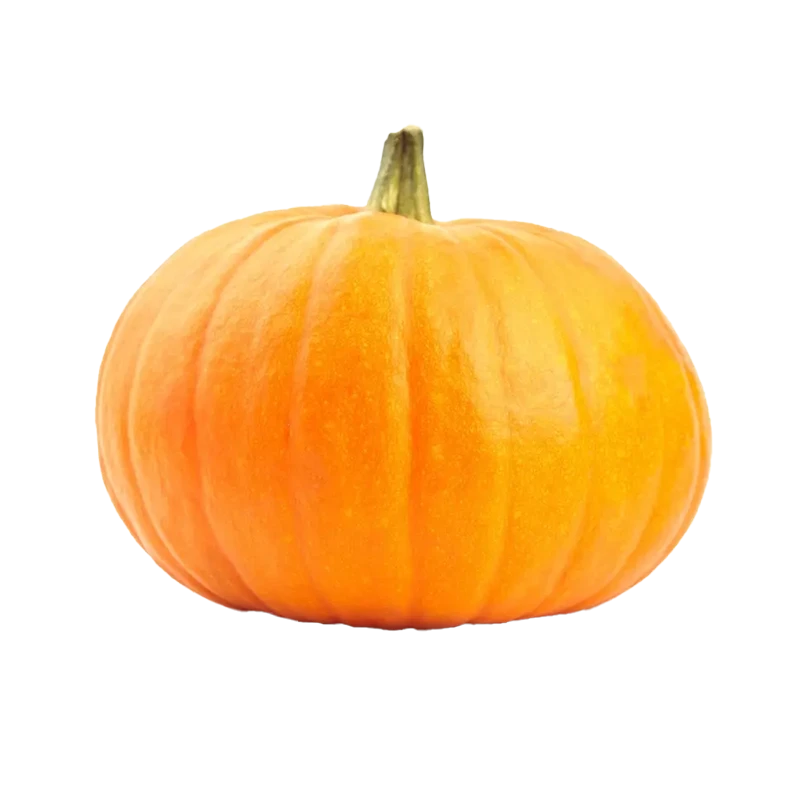Pumpkin — Nutrients, Health Benefits, and Shopping Tips

Written by Listonic Team
Last update on September 6, 2024
Pumpkin nutrients
Nutrition facts
Amount per 100 g
Calories
🔥 26 kcal
| Nutrients per: 100 g | Value | % Daily Value* |
|---|---|---|
| Carbs | 7 g | 2.55% |
| Fiber | 1 g | 3.57% |
| Sugars | 1 g | 2% |
| Glycemic Index | 75 | - |
| Protein | 1 g | 2% |
| Sodium | 1 mg | 0.04% |
| Total Fat | 0 | - |
*The % of Daily Value (DV) tells you how much a nutrient in a serving of food contributes to a daily diet. 2,000 calories a day is used for general nutrition advice.
26
🍏 Low-Calorie Foods
Pumpkin facts & tips
Health benefits
- Rich in vitamins and minerals such as Vitamin A, Vitamin C, potassium, and fiber, supporting overall health and well-being.
- High in antioxidants such as beta-carotene, which help protect the body from free radicals and reduce inflammation.
- Low in calories, making it a nutritious option for weight management and overall health.
- Supports eye health due to its high content of Vitamin A and beta-carotene.
Health risks
- Potential for digestive discomfort such as bloating or gas when consumed in large quantities due to its high fiber content.
- Low calorie content while generally beneficial, can result in low satiety if eaten alone, potentially leading to overeating of other foods.
- Potential for allergic reactions though rare, in some individuals sensitive to pumpkins or other gourds, causing symptoms like itching, swelling, or difficulty breathing.
- Risk of contamination with pesticides or harmful bacteria if not properly washed or sourced from a reputable supplier.
How to choose pumpkin
When selecting a pumpkin, it should have a deep, uniform color and a hard, smooth rind. The stem should be intact and not show signs of mold or decay. The pumpkin should feel heavy for its size, suggesting a dense, moist flesh inside.
Avoid pumpkins that are lightweight or have soft spots, which can indicate they are hollow or starting to rot. Pumpkins with cuts or punctures should also be avoided, as they have a shorter shelf life and may be compromised in flavor and texture.

How to store pumpkin
Whole pumpkins should be kept in a cool, dark area, like a pantry or cellar. This can prolong their freshness for 1-2 months. Once the pumpkin is cut, it should be wrapped in plastic wrap and placed in the refrigerator.
Moisture exposure can lead to rapid decay of pumpkins. It's best to keep them away from heat sources and humid conditions. Always inspect for any soft areas or mold before use, and aim to consume cut pumpkin within 5-7 days.
✅ Extra Tip
How long does it last?
Pumpkin can last for 1-2 months when stored in a cool, dark place. Once cut, it should be refrigerated and used within 5-7 days. Cooked pumpkin can be frozen for up to 6-12 months.
What to do with leftovers?
Leftover pumpkin can be used in a variety of savory and sweet dishes. Mash it and add to soups, stews, or curries for added richness and flavor, or mix it into baked goods like muffins, bread, or pies. Pumpkin is also great when roasted with olive oil and spices for a simple side dish.
Use pumpkin in a risotto or pasta dish with Parmesan and herbs, or blend it into a smoothie with yogurt, cinnamon, and honey for a creamy, seasonal drink. If you have a lot of pumpkin, consider making a batch of pumpkin puree to freeze for later use in soups, sauces, or baking. Pumpkin can also be used as a filling for ravioli or stuffed pasta, or mixed into a quiche or frittata with cheese and greens. For a quick snack, roast pumpkin with cinnamon and brown sugar, then serve with a dollop of yogurt or ice cream.
👨⚕️️ Medical disclaimer
How pumpkin supports specific health conditions
Pumpkin is a nutrient-rich vegetable high in vitamin A, supporting eye health and promoting immune health. It is also a good source of fiber, promoting digestive health and aiding in regular bowel movements. Pumpkin’s antioxidants help protect cells from oxidative stress, supporting heart health. Its low-calorie profile makes it an excellent option for weight management, and its versatility in cooking adds both flavor and nutrition to dishes.
Discover products from other categories
Listonic Team
Fact-checked
Our editorial team checked this article to make sure it was accurate at the time of publishing it.
Get the top-rated shopping list app







